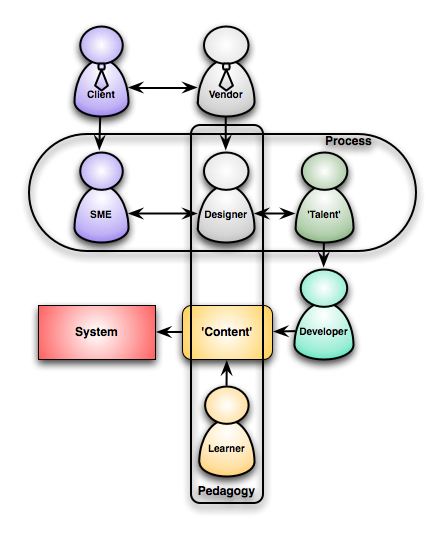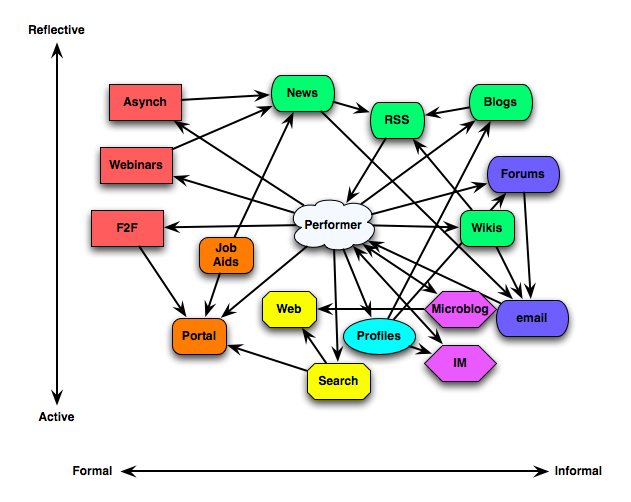I was recently thinking about grades, and was wondering what an ‘A’ means these days. Then, at my lad’s Back to School night, I was confronted with evidence of the two competing theories that I see. One teacher had a scale on the wall, with (I don’t remember exactly, but something like): 96-100 = A+, 91-95 = A, 86-90 = A-, and so on, down to below 50 = Fail. Now, you get full points on homework just for trying, but it’s clearly a competency model, with absolute standards. A different teacher recounted how she tells students that if they just do the required work, that it’s only worth a C, and A’s are for above and beyond. That’s a different model. There aren’t strict criteria for that latter. And I’m very sympathetic to that latter stance, despite that it seems subjective.
The second approach resonates with my experience back in high school, where A’s were handed out for work that really was above and beyond the ordinary. A deeper understanding. We seem to have shifted to a model where if you do what’s asked, you get an ‘A’. And I see benefits of both sides. Defining performance, and having everyone able to achieve them is ideal. Yet, intuitively, you recognize that there’s the ability to apply concepts, and then another level where people can flexibly use them to solve novel problems, combine them with other concepts, infer new concepts, etc.
I was pointed to some work by Daniel Schwartz (thanks @mrch0mp3rs) that grounds this intuition in an innovative framework based upon some good research. In a paper with John Bransford and David Sears, they made a intriguing case for two different forms of transfer: efficient and innovative, and argued convincingly that most of our models address the former and not the latter, yet addressing the latter yielded better outcomes on both. I think the work David Jonassen is doing on teaching problem-solving is developing just this sort of understanding, but it’s on problems that are like real world ones (and yet improves performance on standard measures). And I like David’s lament that the problems kids solve in schools have no relation to the problems they see in the world (and, implicitly, no worth).
Right now, our competencies aren’t defined well enough to support assessing this extra level. In an ideal world, we’d have them all mapped out, and you could get A’s in every one you could master. We don’t live in that world, unfortunately. So we have two paths. We live with our lower measures, and everyone gets A’s meeting them (if they try, but that’s a separate issue), and then sort it out after graduation, in the real world, or we allow some interpretation by the teacher and measure not only effort, but a deeper form of understanding. We’ve steered away from the second approach, probably because of the consequent arguments about favoritism, social stigma, etc. Yet the former is increasingly meaningless, I fear.
We should bite the bullet and admit that we’re waving our hands. Then we could own up that not all teachers are ready to do the type of teaching David’s doing and Daniel’s advocating, and look to using technology to make available a higher quality of content (like the UC College Prep program has been doing) to provide support. I’d rather see a man-in-the-moon program around getting a really meaningful curriculum up online than going to Mars at this point, and I’m a big fan of NASA and the pragmatic benefits of space exploration. Just think such a project would have a bigger impact on the world, all told.
In the meantime, we have to live with some grade inflation (gee, I got into a UC with a high school average below 4.0!), bad alignment between what schools do and what kids need as preparation for life in this century, and a very long road towards any meaningful change. Sigh.
 The point is, we have to quit looking at it as design, development, etc; and view it not just as a process, but as a system. A system with lots of inputs, processes, and places to go wrong. I tried to capture a stereotypical system in this picture, with lots of caveats: clients or vendors may be internal or external, there may be more than one talent, etc, it really is a simplified stereotype, with all the negative connotations that entails.
The point is, we have to quit looking at it as design, development, etc; and view it not just as a process, but as a system. A system with lots of inputs, processes, and places to go wrong. I tried to capture a stereotypical system in this picture, with lots of caveats: clients or vendors may be internal or external, there may be more than one talent, etc, it really is a simplified stereotype, with all the negative connotations that entails.